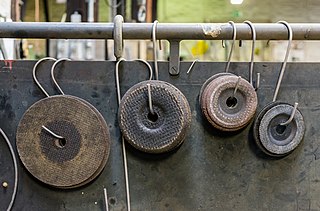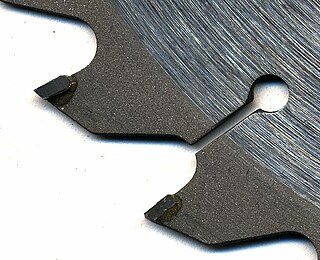
Metalworking is the process of shaping and reshaping metals in order to create useful objects, parts, assemblies, and large scale structures. As a term, it covers a wide and diverse range of processes, skills, and tools for producing objects on every scale: from huge ships, buildings, and bridges, down to precise engine parts and delicate jewelry.

Taps and dies are tools used to create screw threads, which is called threading. Many are cutting tools; others are forming tools. A tap is used to cut or form the female portion of the mating pair. A die is used to cut or form the male portion of the mating pair. The process of cutting or forming threads using a tap is called tapping, whereas the process using a die is called threading.

A machinist is a tradesperson or trained professional who operates machine tools, and has the ability to set up tools such as milling machines, grinders, lathes, and drilling machines.

A drill bit is a cutting tool used in a drill to remove material to create holes, almost always of circular cross-section. Drill bits come in many sizes and shapes and can create different kinds of holes in many different materials. In order to create holes drill bits are usually attached to a drill, which powers them to cut through the workpiece, typically by rotation. The drill will grasp the upper end of a bit called the shank in the chuck.

Sandvik AB is a Swedish multinational engineering company specializing in products and services for mining, rock excavation, rock drilling, rock processing, metal cutting and machining. The company was founded in Gävleborg County, Sweden, in 1862. In 2023, it had approximately 41,000 employees and a revenue of 127 billion SEK, with sales in around 170 countries.
A reamer is a type of rotary cutting tool used in metalworking. Precision reamers are designed to enlarge the size of a previously formed hole by a small amount but with a high degree of accuracy to leave smooth sides. There are also non-precision reamers which are used for more basic enlargement of holes or for removing burrs. The process of enlarging the hole is called reaming. There are many different types of reamer and they may be designed for use as a hand tool or in a machine tool, such as a milling machine or drill press.

Grinding wheels are wheels that contain abrasive compounds for grinding and abrasive machining operations. Such wheels are also used in grinding machines.

Šumperk is a town in the Olomouc Region of the Czech Republic. It has about 25,000 inhabitants. It is an industrial town, but it also contains valuable historical and architectural monuments. The historic town centre is well preserved and is protected by law as an urban monument zone.
Milling cutters are cutting tools typically used in milling machines or machining centres to perform milling operations. They remove material by their movement within the machine or directly from the cutter's shape.

In machining, a metal lathe or metalworking lathe is a large class of lathes designed for precisely machining relatively hard materials. They were originally designed to machine metals; however, with the advent of plastics and other materials, and with their inherent versatility, they are used in a wide range of applications, and a broad range of materials. In machining jargon, where the larger context is already understood, they are usually simply called lathes, or else referred to by more-specific subtype names. These rigid machine tools remove material from a rotating workpiece via the movements of various cutting tools, such as tool bits and drill bits. Metal lathes can vary greatly, but the most common design is known as the universal lathe or parallel lathe.

An end mill is a type of milling cutter, a cutting tool used in industrial milling applications. They can have several end configurations: round (ball), tapered, or straight are a few popular types. They are most commonly used in "milling machines" that move a piece of material against the end mill to remove chips of the material to create a desired size or shape. It is distinguished from the drill bit in its application, geometry, and manufacture. While a drill bit can only cut in the axial direction, most milling bits can cut in the radial direction. Not all mills can cut axially; those designed to cut axially are known as end mills.

A diamond tool is a cutting tool with diamond grains fixed on the functional parts of the tool via a bonding material or another method. As diamond is a superhard material, diamond tools have many advantages as compared with tools made with common abrasives such as corundum and silicon carbide.

IMCO Carbide Tool is an American manufacturing company that researches, designs and manufactures high-performance cutting tools for a variety of applications in the aerospace, automotive, medical, petrochemical, and manufacturing industries. Founded in 1977 by Lawrence R. Osburn and headquartered in Perrysburg Twp, Ohio, IMCO serves a diverse customer base of small job shops to large production operations around the world.

Cemented carbides are a class of hard materials used extensively for cutting tools, as well as in other industrial applications. It consists of fine particles of carbide cemented into a composite by a binder metal. Cemented carbides commonly use tungsten carbide (WC), titanium carbide (TiC), or tantalum carbide (TaC) as the aggregate. Mentions of "carbide" or "tungsten carbide" in industrial contexts usually refer to these cemented composites.

American National Carbide was a privately held company that manufactured tungsten carbide products and was headquartered in Tomball, Texas, which is just northwest of Houston. Also known as "ANC," the company specialized in the production of finished carbide tools for metalworking, rock drilling, and wear applications and was one of a few companies worldwide that was able to recycle tungsten carbide scrap into raw material. ANC, a member of the United States Cutting Tool Institute, was founded in 1970 and sold its products worldwide.

The French Engineering Works, or FEW, is a manufacturer, exporter and importer of High Speed Steel cutting tools. The firm was founded in Johannesburg, South Africa, in 1918 by Herman Moser to manufacture rock drill spares for the mining industry in Johannesburg.

The Ceratizit Group is a joint-stock company (S.A.) and a business area of the Plansee Group, based in Mamer, Luxembourg. Ceratizit is primarily active in the cemented carbide industry. They manufacture cutting tools and products for wear protection, including solid carbide tools and inserts, hard material rods, and wear parts as well as products for wood and stone working. The company is the fourth-largest carbide manufacturer globally and a world leader in industrial applications such as wear protection, wood, and stone working.

Sandvik Coromant is a Swedish company that supplies cutting tools and services to the metal cutting industry.

A magnetic drilling machine is a portable drilling machine with a magnetic base. It can use twist drill bits, annular cutters, milling cutters, and other rotary cutters. With suitable bits it can also tap threads, ream, and countersink. Its combination of a stable magnetic base and low RPM help resist or reduce torque forces created by large diameter bits. Magnetic drilling machines with reversible motor and variable speed controls can also perform operations like tapping, countersink and reaming. A magnetic drilling machine with a cross table base can also perform light milling.
Cutting tool materials are materials that are used to make cutting tools which are used in machining but not other cutting tools like knives or punches.















